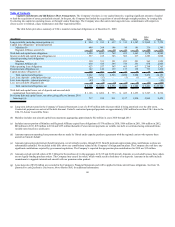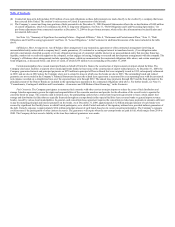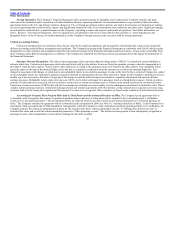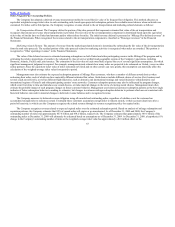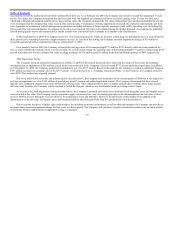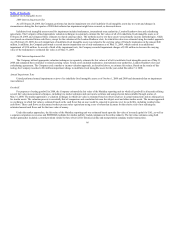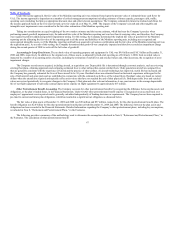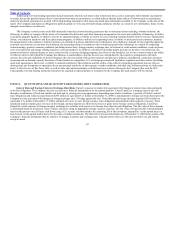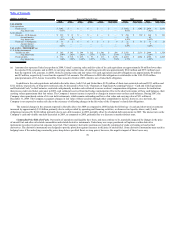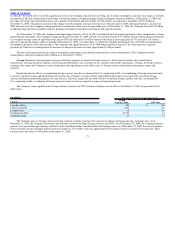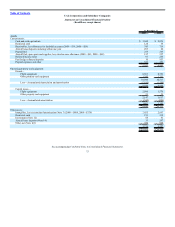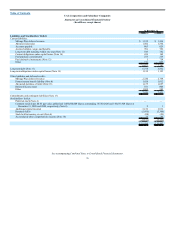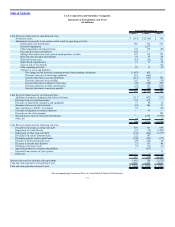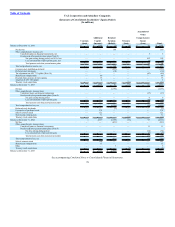United Airlines 2009 Annual Report Download - page 73
Download and view the complete annual report
Please find page 73 of the 2009 United Airlines annual report below. You can navigate through the pages in the report by either clicking on the pages listed below, or by using the keyword search tool below to find specific information within the annual report.
Table of Contents
Additionally, forward-looking statements include statements which do not relate solely to historical facts, such as statements which identify uncertainties
or trends, discuss the possible future effects of current known trends or uncertainties, or which indicate that the future effects of known trends or uncertainties
cannot be predicted, guaranteed or assured. All forward-looking statements in this report are based upon information available to the Company on the date of this
report. The Company undertakes no obligation to publicly update or revise any forward-looking statement, whether as a result of new information, future events,
changed circumstances or otherwise.
The Company’s actual results could differ materially from these forward-looking statements due to numerous factors including, without limitation, the
following: its ability to comply with the terms of its Amended Credit Facility and other financing arrangements; the costs and availability of financing; its ability
to maintain adequate liquidity; its ability to execute its operational plans; its ability to control its costs, including realizing benefits from its resource optimization
efforts, cost reduction initiatives and fleet replacement programs; its ability to utilize its net operating losses; its ability to attract and retain customers; demand
for transportation in the markets in which it operates; an outbreak of a disease that affects travel demand or travel behavior; demand for travel and the impact the
economic recession has on customer travel patterns; the increasing reliance on enhanced video-conferencing and other technology as a means of conducting
virtual meetings; general economic conditions (including interest rates, foreign currency exchange rates, investment or credit market conditions, crude oil prices,
costs of aviation fuel and energy refining capacity in relevant markets); its ability to cost-effectively hedge against increases in the price of aviation fuel; any
potential realized or unrealized gains or losses related to fuel or currency hedging programs; the effects of any hostilities, act of war or terrorist attack; the ability
of other air carriers with whom the Company has alliances or partnerships to provide the services contemplated by the respective arrangements with such
carriers; the costs and availability of aircraft insurance; the costs associated with security measures and practices; industry consolidation; competitive pressures
on pricing and on demand; capacity decisions of United and/or its competitors; U.S. or foreign governmental legislation, regulation and other actions (including
open skies agreements); labor costs; its ability to maintain satisfactory labor relations and the results of the collective bargaining agreement process with our
union groups; any disruptions to operations due to any potential actions by its labor groups; weather conditions; and other risks and uncertainties set forth under
Item 1A, Risk Factors of this Form 10-K, as well as other risks and uncertainties set forth from time to time in the reports the Company files with the SEC.
Consequently, forward-looking statements should not be regarded as representations or warranties by the Company that such matters will be realized.
ITEM 7A. QUANTITATIVE AND QUALITATIVE DISCLOSURES ABOUT MARKET RISK
Interest Rate and Foreign Currency Exchange Rate Risks. United’s exposure to market risk associated with changes in interest rates relates primarily
to its debt obligations. The Company does not use derivative financial instruments in its investment portfolio. United’s policy is to manage interest rate risk
through a combination of fixed and variable rate debt and by entering into swap agreements, depending upon market conditions. A portion of United’s aircraft
lease obligations and related accrued interest ($295 million in equivalent U.S. dollars at December 31, 2009) is denominated in foreign currencies that expose the
Company to risks associated with changes in foreign exchange rates. To hedge against this risk, United has placed foreign currency deposits ($295 million in
equivalent U.S. dollars at December 31, 2009), primarily for euros, to meet foreign currency lease obligations denominated in that respective currency. Since
unrealized mark-to-market gains or losses on the foreign currency deposits are offset by the losses or gains on the foreign currency obligations, United has
hedged its overall exposure to foreign currency exchange rate volatility with respect to its foreign lease deposits and obligations. The fair value of these deposits
is determined based on the present value of future cash flows using an appropriate foreign currency swap rate. The fair value of long-term debt is predominantly
based on the present value of future cash flows using a U.S. treasury rate that matches the remaining life of the instrument, adjusted by a credit spread and, to a
lesser extent, on the quoted market prices for the same or similar instruments. The table below presents information as of December 31, 2009 about certain of the
Company’s financial instruments that are sensitive to changes in interest and exchange rates. Amounts shown below are the same for both UAL and United,
except as noted.
69



